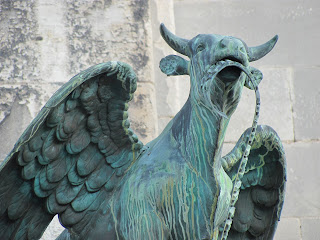
Audrey : We spent so long looking at the lovely Daum collection we didn't get to spend much time in the rest of the museum - which was a pity.
Lillian : Our photographer loved the head-dresses in this painting and that the lady is knitting! Looks like she is working on a sock.
 |
| Le Mariage mystique de St Catherine, Joos van Cleve |
Audrey : Our photographer also likes paintings with lots of costume detail - like this. Hmmm I'd like a head-dress like that myself.
Lillian : The little chap beside her is singing - and holding the music which is written in a very old style of notation - with square notes.
The photo is of some details from Le Mariage mystique de Sainte Catherine by Joos van Cleve, 1514.
 |
| L'Enlèvement d'Hélène by Mathis Gerung, 1531 |
 Audrey : Not so much colour in this painting - all monochromatic except for the faces & hands.
Audrey : Not so much colour in this painting - all monochromatic except for the faces & hands.Lillian : And another painting with a limited palatte, though rather more recent. Les Vestales by Jean Raoux, 1728.
 |
| detail of Les Vestales by Jean Raoux, 1728 |
Audrey : Now this little girl is making quite a fashion statement with her collar & muff of leopard fur.

Lillian : By Adolphe Ulrik Wertmüller and part of a set of portraits of the Charton family. Thomas Charton was an art lover and a patron of Wertmüller, this portrait is probably of Émilie his daughter, it was painted in 1781.
Audrey : Oh! they didn't have faux fur then did they?
Lillian : No, there was no "Acrylicus fakeus" - I'm afraid that fur was real spotted feline. But Adolphe Ulrik Wertmüller had an interesting life - he was born in Stockholm, studied art in Paris, painted Marie Antoinette and George Washington - he ended up migrating to America.
Audrey : Now our photographer also has a 'thing' for representations of the saints with their attributes.

Lillian : ahuh ... and St Lucia / St Lucy is one of her favourites. In this painting St Lucia holds a palm frond - indicating that she was martyred - and in her other hand ...

Audrey : That looks like a cake stand with a pair of Blythe Doll eye-chips on it! Is she the patron Saint of Blythes?
Lillian : Umm I'm not sure if we have one. But the eyes are part of the stories of St Lucy - perhaps not surprising as her name comes from the Latin Lux, Lucis meaning light & you need light to see. In some stories about St Lucy her torturers took out her eyes - in other tales, an admirer praised her beautiful eyes so much that she took them out herself and gave them to him. Anyway, that is why St Lucia is usually depicted with an extra pair of eyes on a golden tray, or holding a pair of eyes like an old fashioned pair of spectacles. Some of Rene Magritte's surrealist paintings have similar pairs of eyes ... Le Liberateur is one such.
Audrey : So St Lucy has an extra pair of eyes ... like us Blythe dolls (only we usually have 4 pairs of eyes each). I think she should be our patron saint.
Lillian : Now we aren't sure which saint this painting was of - our photographer just took photos of the fish-in-a-harness,
Audrey : Looks like a fish hand-bag ... cute idea!
Lillian : Fish are one of the attributes for St Peter but he is most often shown with a key. St Zeno of Verona, patron saint of anglers is often shown with a fishing rod or a fish and St Ulrich of Augsburg is usually shown holding a fish. However, all of those saints are usually shown as older gents in flowing robes. The painting here shows a young man, in green hose (green was associated with youth).
Audrey : I think a fish-shaped hand-bag, done in slightly metallic pleather ... might work in a quirky but cute way.
Lillian : Another quick snap was of this cupid ... from the foreground of a 18thC painting. His rosy red cheeks had us wondering if the artist had only ever seen babies with nappy rash.
Lillian : The Musée des Beaux-Arts is in one of the beautiful white lime-stone buildings facing Place Stan - there is a really beautiful sweeping staircase...
Here is the view from one of those windows - looking down into Place Stan.

Audrey : And looking at all those people dining under the umbrellas made us realise that we hadn't eaten for hours!
Lillian : So we had a lovely little picnic with yummy doll-sized food.
Audrey : I was so tired - and my feet were too!
















































